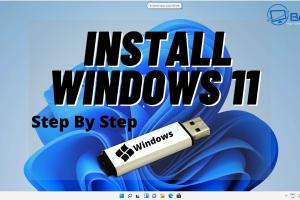How to Download Windows 11: A Quick Step-by-Step Guide

-
Quick Links:
- Introduction
- System Requirements
- Preparing for Download
- Downloading Windows 11
- Installing Windows 11
- Common Issues and Solutions
- Expert Insights
- Case Studies
- Conclusion
- FAQs
Introduction
Windows 11 has made a significant impact on the technology landscape since its release. With a user-friendly interface and enhanced features, many users are eager to upgrade from older versions of Windows. This guide offers a comprehensive step-by-step process for downloading Windows 11, ensuring that even those with limited technical knowledge can do it effortlessly.
System Requirements
Before diving into the download process, it's crucial to ensure that your device meets the system requirements for Windows 11. Here’s what you need:
- Processor: 1 GHz or faster with at least 2 cores on a compatible 64-bit processor or System on a Chip (SoC).
- RAM: 4 GB or more.
- Storage: 64 GB or larger storage device.
- Firmware: UEFI, Secure Boot capable.
- TPM: Trusted Platform Module (TPM) version 2.0.
- Graphics: DirectX 12 compatible graphics / WDDM 2.x.
- Display: >9” with HD Resolution (720p).
- Internet Connection: Internet connectivity is necessary to perform updates and to download and take advantage of some features.
Preparing for Download
To ensure a smooth download process, follow these preparatory steps:
- Backup Your Data: Always create a backup of important files before upgrading to a new operating system.
- Check for Updates: Ensure your current version of Windows is up to date. Go to Settings > Update & Security > Windows Update and install any pending updates.
- Free Up Space: Make sure you have enough storage available on your device.
Downloading Windows 11
Now that you are prepared, here’s how to download Windows 11:
Step 1: Visit the Official Microsoft Website
Go to the official Windows 11 download page.
Step 2: Choose Your Download Option
You can choose to upgrade directly from Windows 10 or create installation media:
- Upgrade Now: If you’re already on Windows 10, click on "Upgrade Now" to download Windows 11 directly.
- Create Windows 11 Installation Media: If you want to perform a clean install or upgrade another PC, download the Media Creation Tool.
Step 3: Follow the Prompts
Once you've selected your option, follow the on-screen prompts to complete the download. The process may take some time depending on your internet speed.
Installing Windows 11
After downloading, you’ll need to install Windows 11. Here’s how:
Step 1: Run the Installer
If you used the Media Creation Tool, insert the USB drive and run the setup.exe file. If you upgraded directly, follow the prompts that appear after the download completes.
Step 2: Accept License Agreement
Read and accept the Microsoft Software License Terms to proceed.
Step 3: Choose Installation Type
You can choose to keep your files and apps or perform a clean installation. Select your preferred option.
Step 4: Complete Installation
Follow the remaining prompts to complete the installation. Your PC will restart several times during the process.
Common Issues and Solutions
While downloading and installing Windows 11 is generally straightforward, some users may run into issues. Here are a few common problems and their solutions:
- Installation Failed: Ensure your device meets all system requirements, and check your internet connection.
- Not Enough Space: Free up space by deleting unnecessary files or applications.
- Driver Issues: Update your drivers before starting the installation process.
Expert Insights
Experts recommend ensuring that your device is fully compatible with Windows 11 before attempting to upgrade. Additionally, creating a full system backup can prevent data loss if something goes wrong during the installation.
Case Studies
Many users have successfully transitioned to Windows 11. For instance, a survey conducted by TechRadar found that 68% of users reported increased productivity after upgrading. Another study by ZDNet highlighted that Windows 11 users experienced fewer crashes and improved performance in demanding applications.
Conclusion
Downloading and installing Windows 11 can be a smooth process if you follow the outlined steps. By ensuring your system meets the requirements and preparing accordingly, you can enjoy all the new features and improvements Windows 11 has to offer.
FAQs
1. Can I download Windows 11 for free?
If you have a valid license for Windows 10, you can upgrade to Windows 11 for free.
2. What if my PC doesn't meet the requirements?
You may need to upgrade your hardware to meet the minimum system requirements for Windows 11.
3. How long does the download take?
The download time varies based on your internet speed, but it typically takes between 30 minutes to an hour.
4. Can I uninstall Windows 11?
Yes, you can roll back to your previous version of Windows within 10 days of upgrading.
5. Will my applications work with Windows 11?
Most applications compatible with Windows 10 should work with Windows 11, but it’s good to check with the software developers.
6. Is Windows 11 better than Windows 10?
Windows 11 offers a more streamlined interface and improved gaming features, making it preferable for many users.
7. What if I face installation errors?
Check your hardware compatibility and ensure you have enough disk space. Microsoft's support page offers solutions for common errors.
8. Do I need to create a backup before upgrading?
It is highly recommended to back up your files before proceeding with the upgrade.
9. Can I use my Windows 10 product key for Windows 11?
Yes, if your Windows 10 is activated, your product key will work for Windows 11.
10. How do I check if my PC is compatible with Windows 11?
You can use the PC Health Check tool available on Microsoft's website to verify compatibility.